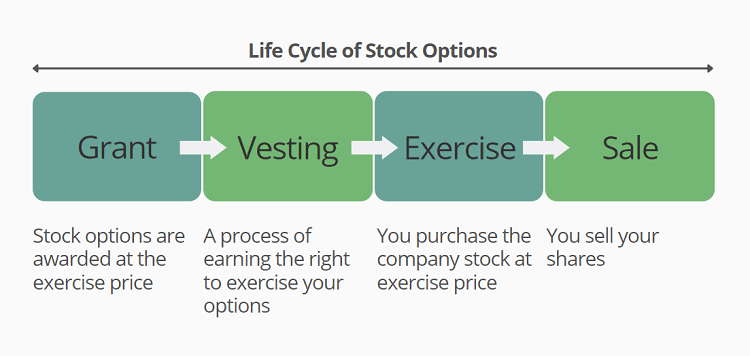Employee stock options are designed to motivate and retain current employees and help lure top talent. So it’s important to be transparent with your team to maximize acceptance, trust and appreciation.
To achieve this, a communication strategy is an effective way to talk to your employees about their stock options. Here are some steps to take:
- Explain why employees receive stock options by running modeling scenarios
- Identify what employees have to know about their stock options
- Start from the recruitment process and continue
- Speak plainly with examples and images
- Use a variety of comms channels
- Let participants tell their own story
- Get feedback from your employees
Explain why employees receive stock options by running modeling scenarios
The main goal for companies in offering employees stock options is to motivate them to work harder, as their performance ties in with the company’s stock value.
Employers often use the story of David Choe, who painted Meta’s (formerly Facebook) first office and asked for stock instead of cash. That was in 2005, and the stock was worth $200 million ten years later. However, realistically, many people know that this was only one of a few success stories.
So, you can instead run some modeling scenarios with hypothetical but realistic scenarios. Assuming your company is private, you can get the numbers on what their equity looks like after a potential next round of funding, and another, all the way to going public.
Identify what employees have to know about their stock options:
It’s important that your employees know what they’re signing up for, so make sure these employee stock option basics are included in your comms plan:
- Types of employee stock options, e.g. ISOs, NSOs
- Process (Grant -> Vesting -> Exercise -> Sell)
- Key dates and timeline
- Rules: vesting schedule, exercise window and determination rules
- Tax implications (A bigger tax hit may occur when exercising. So, this part has to be well communicated)
Stock option agreement
If your employees hope to purchase and sell their stock someday, they’ll need to accept a stock option agreement. By accepting it, they’re giving themselves the opportunity (but not the obligation) to exercise the options at a future date.
The stock option agreement has to lay out all details including
- Name of participant
- Total number of option shares
- Type of option
- Exercise price per share
- Date of grant
- Exercise period
- Vesting start date
- Expiration date
If you want to get people to buy-in, you shouldn’t just pray for the result. You should instead start early to communicate what an employee stock option is and why it matters to employees.
Start from the recruitment process and continue
One of the benefits of employee stock options is to attract top talent in recruitment. So, you should mention your stock option plan during recruitment efforts.
You need to clearly list it in the job description and mention it in the interviews. When you offer a candidate a job offer, use this opportunity to educate them on what employee stock options are. You can use your job offer letter or a separate document to explain the employee stock option basics (see above) and lay out the timeline. By doing so, your employees will feel how the management deals with employee issues and are likely to become emotionally attached to their work.
You also want to continue doing it after the hiring process. There should be a lot of talks during orientation and onboarding about the benefits and importance of employee stock options.
Speak plainly with examples and images
Make sure to explain it in clear, jargon-free language when showing your employees stock options. Nothing sinks your option plan enrollment faster than employees not understanding what exactly they’re enrolling in. If they don’t understand it, they won’t trust it.
That’s why explaining something complicated with examples or images is always good. For example, in your job offer letter, you can consider using graphs/charts like the one below to explain the stock option lifecycle and the meaning of each stage.

As discussed, tax is one of the key topics to educate your employees because you don’t want to surprise them with a huge tax bill. A summary table along with calculations can help explain and simplify the whole concept.
Use a variety of comms channels
A single approach doesn’t work because we process information differently – some prefer to read while some prefer to listen.
It’s a good idea to use a variety of channels to reach your employees such as an intranet, blogs, town hall meetings, zoom meetings, lunch-and-learns, well-designed newsletters and videos and others.
Let participants tell a story
People connect to stories. They tap into our emotional side and make us react—which is what you need to change how people behave.
So, you can identify some employees who are interested in your employee stock options, and ask them why they are interested in joining and what their end goals are. You can also share stories from previous participants like how they’ve benefited from the scheme.
Using these testimonials can make a real connection, resulting in a far greater impact than any expensive campaigns.
Get feedback from your employees
Communication is a two-way street. Too often, companies focus on throwing out as much information as they could. But the other side – what employees think and feel – is arguably more important.
So, make sure you get feedback from your employees and encourage them to ask questions so that you can improve your communication strategy.
Now that you know a few ways to explain stock options to your employees, contact Global Shares to discuss more ways to make your plan the best it has ever been.
This publication contains general information only and J.P. Morgan Workplace Solutions is not, through this article, issuing any advice, be it legal, financial, tax-related, business-related, professional or other. J.P. Morgan Workplace Solutions’ Insights is not a substitute for professional advice and should not be used as such. J.P. Morgan Workplace Solutions does not assume any liability for reliance on the information provided herein.



